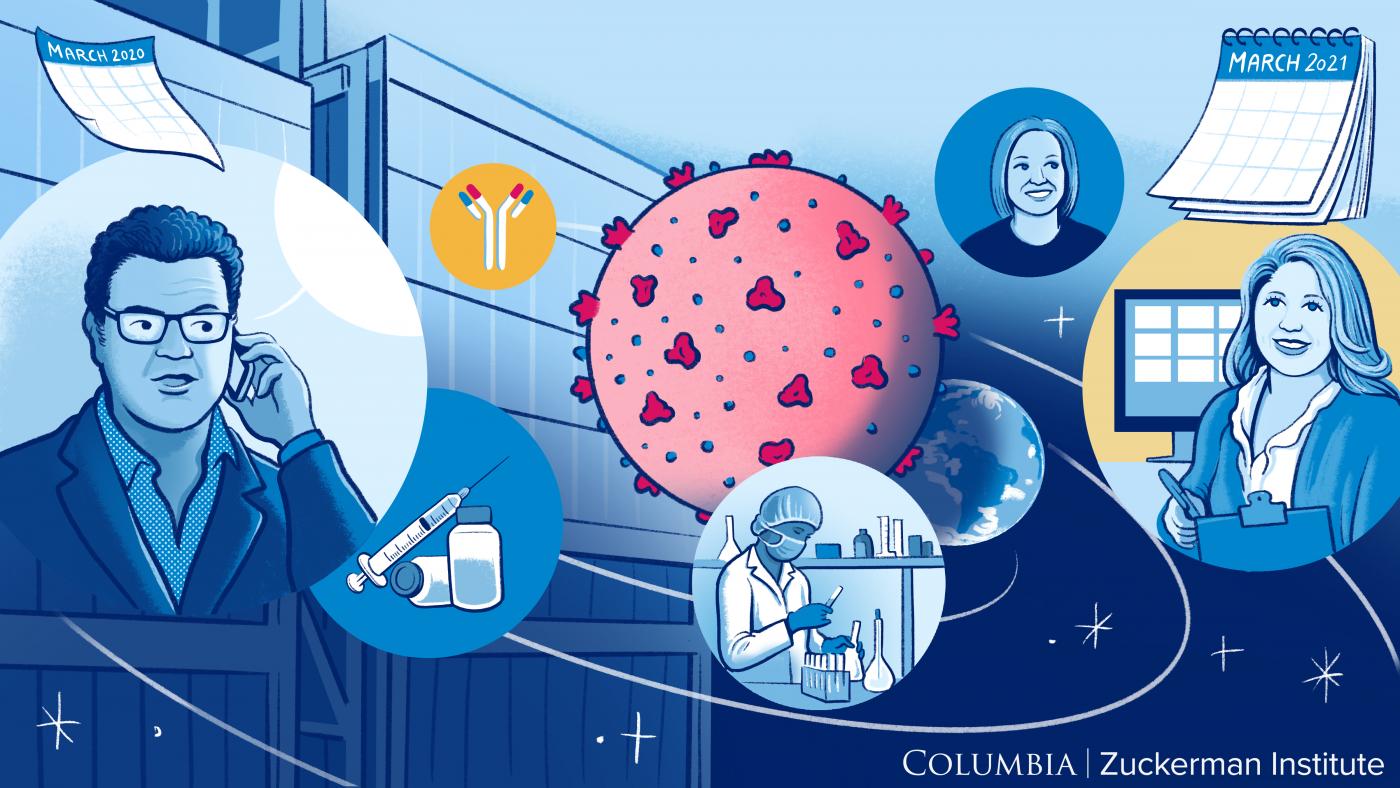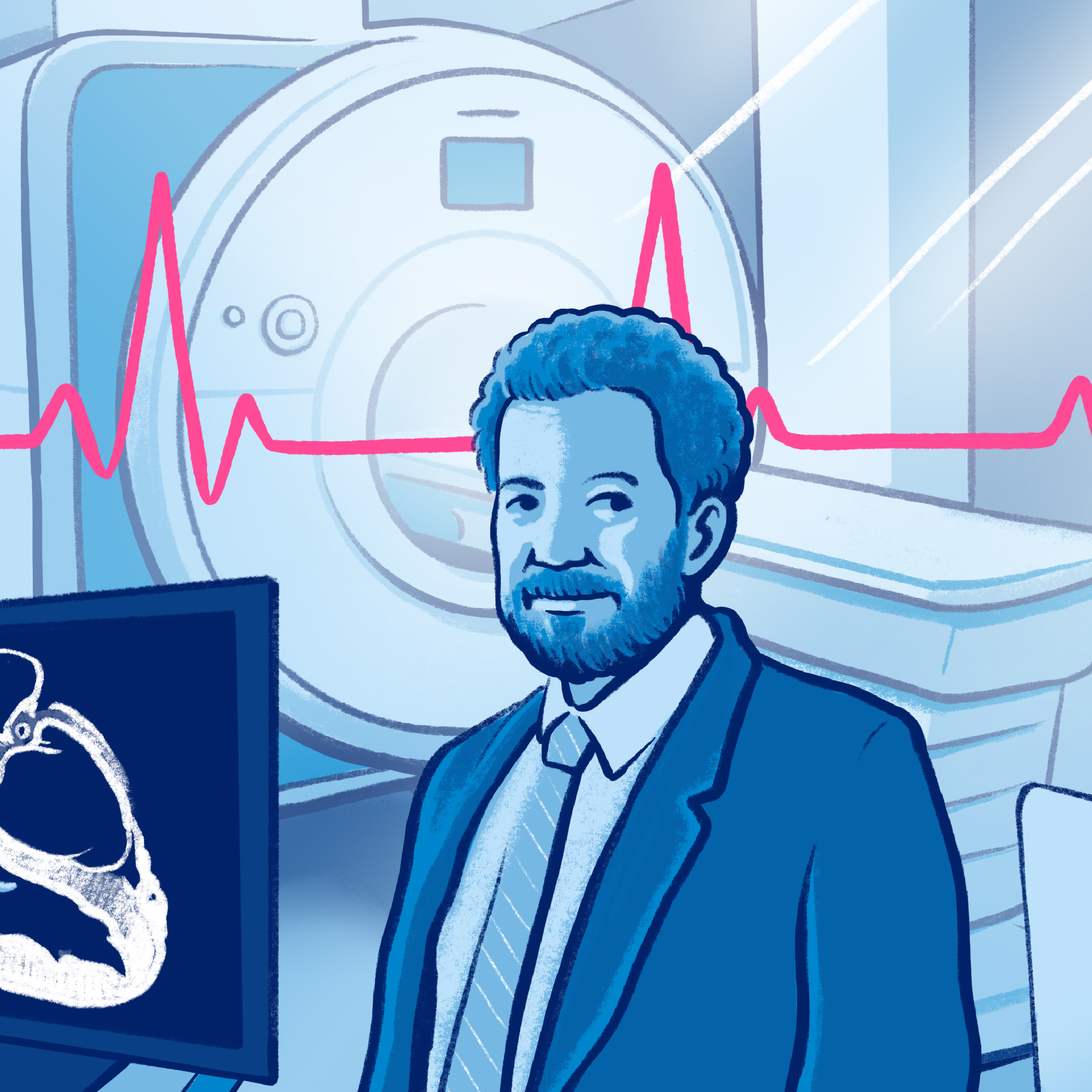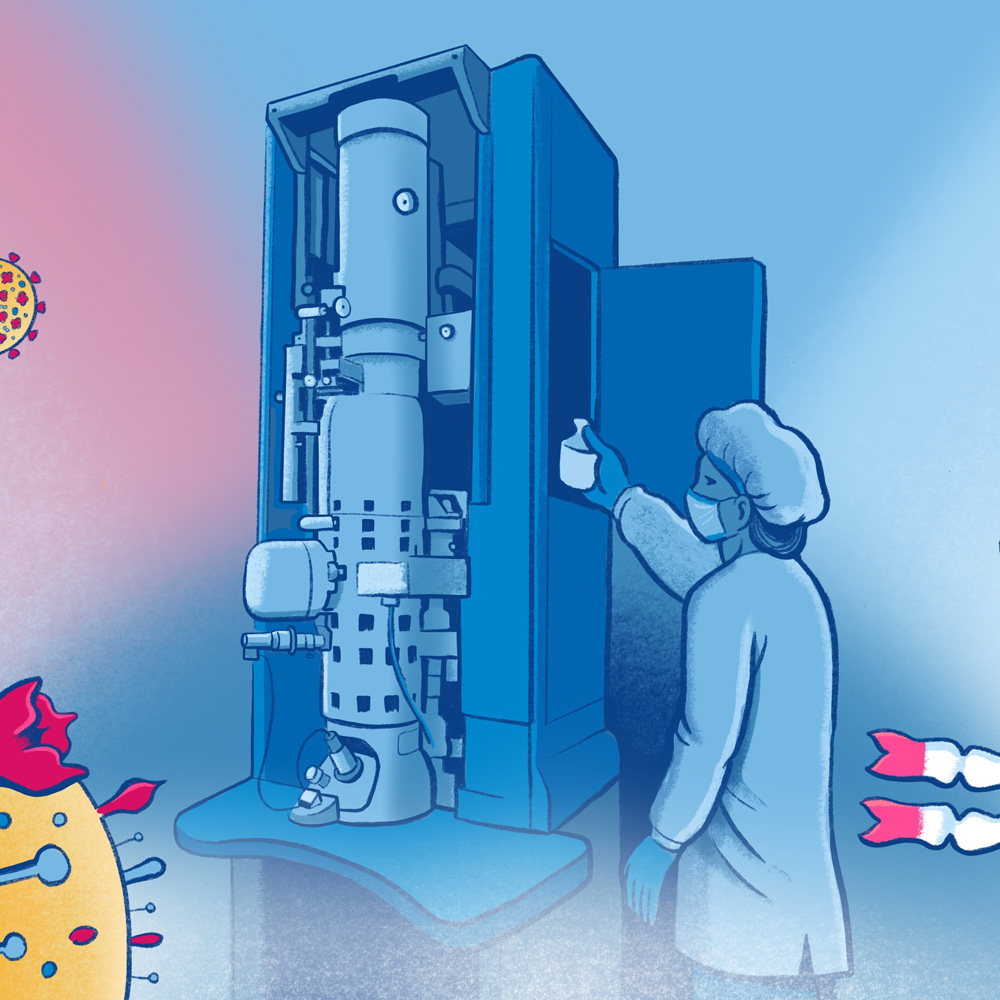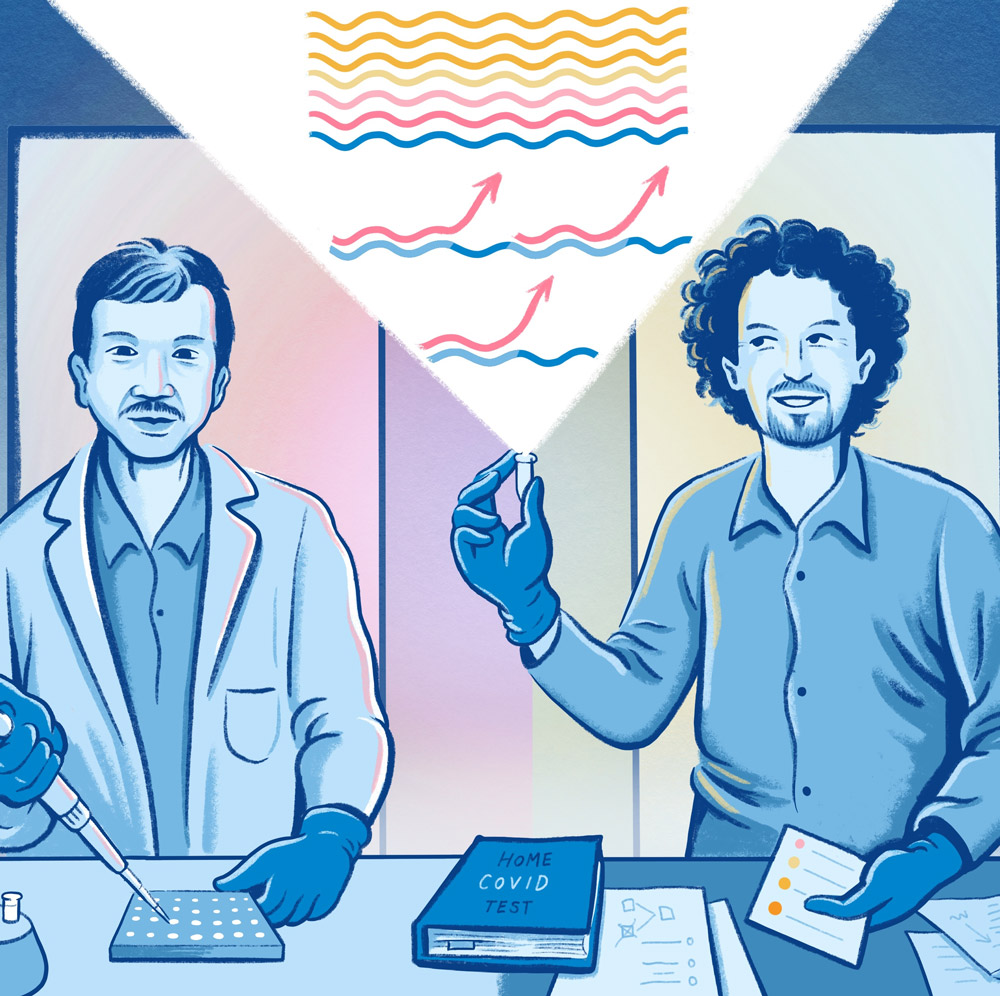KATHLEEN DURKIN I’m Kathleen Durkin of Columbia’s Zuckerman Institute.
DEVIN POWELL And I’m Devin Powell of the Zuckerman Institute.
KATHLEEN Welcome to Lab in the Time of Coronavirus. This podcast follows the lives of brain scientists who are pivoting to combat COVID-19 in this time of crisis.
DEVIN So it’s been a little over a year since we started this podcast. And we thought we’d start today by thinking back to last March, which if you may remember was a confusing time.
KATHLEEN The World Health Organization had declared COVID-19 a pandemic.
DEVIN I remember people were sanitizing their deliveries and grocery bags.
KATHLEEN We were told not to wear masks. And then we were told to wear masks.
DEVIN And research institutes across the world were trying to figure out: what do we do, in the middle of all of this chaos?
JENNIFER FARRIS You come back off the holidays, things start to get a little bit busier in mid-January, and February is typically a super-busy month. All of a sudden, the world stopped.
DEVIN That’s Jennifer Farris. She’s the chief operating officer at the Zuckerman Institute. She quickly realized that her job needed to change in these suddenly strange circumstances we found ourselves in.
FARRIS The first week, we had to kind of get our act together pretty quickly. I have a background in operations, so I was fully knowledgeable about what to do in the case of an emergency. And one of the first things you do is manage your communication channel. My job at that point became chief communicator.
DEVIN The conversation started with the safety of people at the Institute.
FARRIS We just collectively said, “Look … we need to protect our people and we need to also protect their sense of safety. We need to give them some sense of control over their lives and level with them.” And even though nobody around us was saying it, we went ahead and had an all-employee meeting, you all probably remember, and we told everybody you’re likely not going to come back for a long time. I just remember it got real quiet, then after the meeting I got a flood of thank yous: people saying, “Now I can move forward. Now I can do something, I can make a plan.”
DEVIN And what about the hundreds of scientists and other research workers who were conducting experiments and keeping the facilities running? The Institute tried to work out who had to be in the building to prevent years of research and hard work from disappearing.
FARRIS We had done these analyses: we could bring 20 percent of people back, we could do this, and it was all based on the R-naught number, right, because all of a sudden we’re all experts now on that. And so one night we worked overnight to pull together a spreadsheet of all of the essential people that needed to be in the building.
DEVIN One of the first challenges they faced in those early days was getting masks to protect those essential personnel.
FARRIS Kudos to our team. We had some boxes and some shipments coming in when others couldn’t. We as a result were able to actually donate quite a bit. We were also able to save what we needed for the work that needed to get done in our building. It was chaos. I remember there was this one woman who reached out to us. I don’t even know how she got our information. She was the head of a nursing home in the neighborhood, and she was pleading for masks. And so, literally, Barbara Han and our operations team packaged up some stuff, put it in a box, called the lady. We put it outside the door, because no contact, right? Her husband came and picked it up, and we got a nice little note from her that we had provided them with PPE that they were so desperate for.
KATHLEEN Early on, the team realized that testing would be an important part of being able to reopen.
JEN ADAMS In order to bring people back into the building safely, we needed to be able to test and to monitor the cases. We needed to figure something out and we needed to do it quickly. So we started a boots-on-the-ground effort to figure out who else is testing, who else has connections that we could partner with.
KATHLEEN That’s Jen Adams. She had been hired only a few weeks before the pandemic hit, to serve as Zuckerman’s senior director of administrative services. Now she found herself leading the effort to bring coronavirus testing to the Institute.
ADAMS My background is hospitality operations, so coming in and then having a pandemic hit, I first felt like I didn’t know, you know, what is serology, what is COVID-19, what does quarantine mean? I had no idea. I spent a lot of time reading and trying to learn and understand. I think we all were just on adrenaline, and we knew that we were making a difference by helping further this critical research.
KATHLEEN Jen started making calls.
ADAMS We reached out to the State of New York. We reached out to Bloomberg. At the time there were all sorts of collaborations that were happening in terms of getting this testing program in the state going. And we were connected with a start-up out of San Francisco that was partnering at the time with the New York Genome Center for a testing program. And we were on the phone with this group I can’t even begin to tell you how many hours. We basically plotted out how we would be able to start a testing program. And we went through all of the steps of how are we going to monitor this, how often will we test? It is a swab or a spit test? What is the process of getting this to the lab? We mapped out everything. The late nights that we spent on the phone talking through all sorts of different scenarios, now, looking back, first of all, I am so much closer with all of my colleagues as a result of it. I have met so many people throughout the university as a result that I have never even met in person. We all felt like this one small little thing could actually be impactful and is making a difference.
DEVIN The nimble team shared what they learned. Director and CEO Rui Costa, DVM, PhD, chaired efforts to bring testing to Columbia as the university ramped up.
KATHLEEN As the months dragged on, other issues emerged. Schools shut down. Family members became sick. And it was clear that the caregiver obligations at home placed a greater burden on the women than the men of the Zuckerman Institute. Rui and the team started thinking about the support that members of the community needed.
We all were just on adrenaline, and we knew that we were making a difference by helping further this critical research.
DEVIN For Rui, one of the biggest challenges over this last year has been helping people to stay mentally healthy.
RUI COSTA Science is done with our brains. And to me, the most scary thing after the deaths and COVID 19 was mental health issues. People were alone. I struggled many times with anxiety, depression. I didn’t even know. My mentor died with COVID-19, and she realized she was going to die. She had dialysis, and she said, “Rui, it’s going to hit here.” She was an immunologist. Then she wrote a poem that I then shared with the lab and the world about her knowledge of what was about to come. And so that was very powerful. Most conversations that I had about the Institute, you know, even besides policies and stuff was, “Are you okay?” “Are you okay?” back. And this affected everyone beyond anything I’ve seen, and it affected people of all ages, at all stages of their scientific career.
DEVIN The pandemic didn’t affect everyone the same way.
COSTA We don’t realize how different the realities are for different groups. The people that work every day, from the people that clean our building, take care of our animals, some of them are contractors, and they have a certain amount of leave. They were afraid of getting sick or getting a fever not because they were afraid of getting the disease, but they were afraid of going without pay. They were like, “Rui, if we go home, and we have two weeks of leave, if I have to stay longer then I can’t survive.” So we changed some of those contractors to be permanent workers.
DEVIN The new reality exposed underlying issues that predated COVID-19.
COSTA Inequities and lack of inclusion that we hadn’t realized. It led us to correct it. So one of the early conversations was how can we help women that have families or, in some cases, men that have families and kids, but also dependent care. Elderly people or people with other problems, health problems, needed to be taken care of, and some people are the primary caregivers in their family. And so we had a strong discussion at the university level, but we decided at Zuckerman. Some people needed help on daycare, some people wanted to bring kids closer to work. It was hard to find a solution that would fit everyone.
KATHLEEN The Institute gave financial assistance to those with children.
COSTA And that had I think a big positive impact, at least psychologically and sociologically. People felt they matter. We’re not naïve in thinking it resolved the problems, it didn’t, it just put a little weight on the other side of the scale. But it also revealed, like I mentioned, a long-standing bias. On top of this, we had a realization of the tremendous inequalities and biases and racism in our society. This all relates to the same thing. It’s about being better as humans, organizing ourselves better, being more equal, less biased. We’re now working towards more stable policies that would try to resolve those issues long-term.
KATHLEEN It’s been a tough year for everyone. But there are some positives. Rui noted the pressure for science to become more open and accessible.
COSTA We saw great examples on the research related to COVID. Certainly, it put pressure. What about people dealing with Alzheimer’s or Parkinson’s? Those brain disorders affect more people than COVID. Why aren’t we doing this in other disorders that are even a larger pandemic? Most, the very vast majority of our research, is publicly funded. So the public has the right to know the results. “Rui, you said you were going to test hypothesis A. We gave you the money. What are the results of the test of hypothesis A?” It’s less okay by society to not share.
DEVIN In another positive, Jen Adams sees a new hybrid model for the Institute that allows people to work in different ways.
ADAMS I really want to come back from this pandemic on a greater scale. I think in many ways this is such an opportunity for us, whether it’s technology or just thinking outside of the box of how we use our space. Or what our collaborations look like in a new world. I think that’s really at the forefront of my mind now. Just living in Manhattan alone poses a challenge for a lot of people. And the fact that now people can have a more flexible schedule, can focus on their lives and what works for them and yet still maintain their jobs and maintain the connection with their colleagues with a click of a button, I think is really amazing.
KATHLEEN And for Jennifer Farris, seeing the way the Zuckerman community has come together has been inspirational.
FARRIS You know, there are people that when there’s an emergency or a disaster, they run away or they run towards. Our administrative group ran towards what was going on. And that was pretty cool. Those first few weeks, we’re over here trying to figure out what we’re going to do, how we’re going to schedule people, who’s essential, all that stuff. And in the meantime literally every day I would get ten, fifteen, twenty emails from people in various labs pleading for me to please give them something to do, some job that they could do to help. People showed up.
KATHLEEN Thanks for listening to Lab in the Time of Coronavirus. Take a look at the show notes for links to all the things we discussed. You can find all of our episodes at https://zuckermaninstitute.columbia.edu or on iTunes. Take a moment to rate and review us on iTunes. That makes it easier for other people to find us.
DEVIN Special thanks to Rui Costa, Jennifer Farris, and Jen Adams for sitting down with us for this episode, and the entire Zuckerman team. The music was provided by Miguel Zenón, Jazz Artist-in-Residence at the Zuckerman Institute. If you have thoughts or questions, you can find us on Twitter and Instagram @ZuckermanBrain. But before we go, Kathleen I think you had one last question for our researchers?
KATHLEEN What is the first thing you plan to do, post-pandemic?
DEVIN Here’s Jennifer Farris.
FARRIS I am going to take a scuba diving trip.
KATHLEEN Jen Adams.
ADAMS Jump on an airplane and travel everywhere.
DEVIN And Rui.
COSTA Hug my parents probably.



